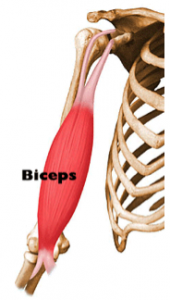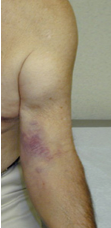Distal Biceps Tendon Tear
The biceps muscle of the upper arm begins at the shoulder, extends down the arm, crosses the elbow joint, and attaches onto the upper portion of the forearm (at the radius bone).
At each end of the muscle is a tendon, which attaches the muscle to the bone. The tendon that attaches the biceps muscle to the radius bone of the forearm is known as the distal biceps tendon.
Tears of the distal biceps tendon are usually the result of a sudden injury in which the patient sustains an eccentric contraction of the biceps; in other words, the patient attempts to flex the elbow, but the elbow is extended against a heavy force which overpowers the strength of the biceps. Less commonly, the tendon can be injured when the elbow is forcibly bent against a heavy load.
Injuries to the distal biceps tendon are most common in males, especially over the age of 35.
Distal biceps tendon tears can be either partial or complete. Partial tears are rare and occur when a portion of the tendon remains intact, but a portion of the tendon tears away from the bone. More commonly the entire tendon tears, or ruptures, and pulls away from the bone (see picture below).
Signs & Symptoms:
Typically patients report an acute injury, often while attempting to lift a heavy object. Patients frequently report hearing or feeling a pop and having immediate pain in the front of the elbow. The pain usually subsides gradually with time, but swelling, bruising, and deformity of the biceps muscle typically ensue in the days following the injury (see picture below).
Patients also report pain and weakness with attempted elbow flexion and supination activities.
Diagnosis:
The diagnosis of a distal biceps tendon tear is typically made by a combination of the patient’s history and the findings on physical examination. X-rays are frequently obtained to rule out other injuries. An MRI scan is used to confirm the diagnosis and determine whether the tear is a partial tear or a complete rupture.
Treatment:
The treatment of distal biceps tendon ruptures depends upon the age, health, and activity level of the patient as well as the extent of the tendon injury (ie partial tear versus complete rupture).
For older, less active patients, and those with severe medical problems which preclude safe surgery, non-surgical treatment is recommended. In addition for patients with partial tears representing less than 50% of the tendon thickness, non-surgical treatment is typically recommended initially. Non-surgical treatment consists of icing, anti-inflammatory medications, bracing, activity modifications, physical therapy, and a gradual return to activities as tolerated.
For most young, active, healthy patients with complete tendon ruptures or partial tendon ruptures which represent more than 50% of the tendon thickness, surgical treatment is recommended. Surgical treatment is ideally performed within 2-3 weeks from the date of the initial injury before the tendon and muscle begin to scar and shorten and make reattachment it to its native position more difficult. Surgery consists of reattaching the ruptured tendon back to its insertion on the radius bone of the forearm.


